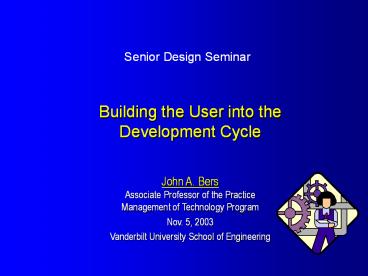Building in the User-Lecture Notes - PowerPoint PPT Presentation
1 / 18
Title:
Building in the User-Lecture Notes
Description:
Impact What effects will it have on the user's business? ... Guides design tradeoffs. e.g., price vs. features vs. performance ... – PowerPoint PPT presentation
Number of Views:15
Avg rating:3.0/5.0
Title: Building in the User-Lecture Notes
1
Senior Design Seminar
Building the User into the Development Cycle
John A. Bers Associate Professor of the
Practice Management of Technology Program Nov. 5,
2003 Vanderbilt University School of Engineering
2
What things dont we know about our new product?
- Performance Can our product do what we claim?
- Applications What will customers use it for?
- Market Awareness/Interest Do they care?
- Receptiveness Will they accept it?
- Preference Will they prefer it to the
competition? - Features What do customers want from our
product? - Pricing How much are they willing to pay for
it? - Compatibility Will it fit in with the users
operations? - Impact What effects will it have on the users
business? - Reliability Will our product hold up in the
field? - Support What will it take to support our
product? - Timing When will our product take off?
3
Design as an Iterative Process
- A conversation between developer and user.
4
The user as a partner and a resource
5
What Can You Learn from User Surveys?
6
What You ProbablyCant Learn from Surveys
- Motivations - Why they feel and act as they do
- Underlying customer business processes
- Future Behavior
- intentions and plans
- behavior expected to depart radically from the
past
Beware the question starting with Would !
7
Rapid Prototyping
- Frequent, low-risk market incursions
- use product itself as a market probe
- listen, observe market reaction
- vary, recalibrate the product
- shoot again
8
What you can gain from observation and controlled
trials
- Actual usage experience that cannot be captured
by any other method - Minimize/address surprises
- Impacts on the users business
- compatibility with existing operations
- unanticipated side effects
- measurable business and financial impacts
- User input/involvement in the design cycle
9
Implementing Rapid Prototyping
- Target lead users (early adopters, innovators)
Pre- Launch
10
The best prospect for user-innovatorthe Lead
User
- faces needs today that the general market wont
face for months or years - is able to benefit significantly from a solution
to those needs - may be an industry opinion leader
- (disproportionate influence)
- culture open to new technology
11
Examples of Lead Users...
- Technology/Industry
- Textiles
- Financial Services
- Composites
- Parallel Processing
- Retailing Systems
- Medical Diagnostics
- Law Enforcement
- Lead User
- Milliken
- Citicorp
- Air Force
- Oil Industry
- Wal-Mart
- Teaching Hospitals
- FBI
Best lead user may be outside your industry.
12
Implementing Rapid Prototyping
- Target lead users
- Involve potential users early in the development
cycle - Make product easy for users to try out
- Start with peripheral or minor applications
(reduce adoption risk)
Pre- Launch
13
Implementing Rapid Prototyping
- Target lead users
- Involve potential users early in the development
cycle - Make product easy for users to try out
- Start with peripheral or minor applications
Pre- Launch
Post- Launch
- Design product for user to modify.
- Encourage users to share their results with you.
14
Instrumenting the Site
- Variables to be measured during the trial
- Usage parameters
- Who, how, how much
- Results
- Problems (surprises)
- Business Impact
- Fit within the operations
- Impact on the business (ROI)
- Ancillary Needs
- Related unmet needs
- Opportunities for new products, extensions
15
Example of User-guided DesignThe HP Network
Advisor
Users need more data, reports
Help my users recover from crashes
Result HP Network Advisor
16
Exercise Taking Palm to the Factory Floor
- Product Objective
- Real-time tracking of work-in-process, raw
materials, components, inventory - Business Objective
- Catch defects, flag component shortages, keep
supply chain taught - Assignment
- What would you want to learn from prospective
users? - How would you find it out?
17
Benefits of User Involvement
- Helps establish design objectives
- The who-what-when of the target market
- Guides design tradeoffs
- e.g., price vs. features vs. performance
- Stimulates discovery of new directions and
opportunities - e.g., features, new applications, unsolved
problems - Lets you home-in faster on what market will buy.
18
A Spring 04 course to considerMT242 Technology
Marketinghttp//mot.vuse.vanderbilt.edu/marketing
/
- If youre interested in working for a company
that is working in the field of your design
project - If you intend to take the project to market
- If you want to develop and refine your skill sets
in analyzing technology markets and developing
market strategies - You may use the marketing course project to
develop a market analysis and plan for your
senior design project. - Only one team member need enroll.































